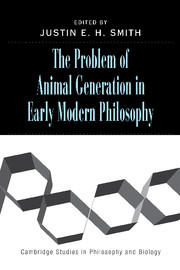Book contents
- Frontmatter
- Contents
- List of Contributors
- Introduction
- I THE DAWNING OF A NEW ERA
- II THE CARTESIAN PROGRAM
- 3 Descartes's Experimental Method and the Generation of Animals
- 4 Imagination and the Problem of Heredity in Mechanist Embryology
- III THE GASSENDIAN ALTERNATIVE
- IV SECOND-WAVE MECHANISM AND THE RETURN OF ANIMAL SOULS, 1650–1700
- V BETWEEN EPIGENESIS AND PREEXISTENCE: THE DEBATE INTENSIFIES, 1700–1770
- VI KANT AND HIS CONTEMPORARIES ON DEVELOPMENT AND THE PROBLEM OF ORGANIZED MATTER
- VII KANT AND THE BEGINNINGS OF EVOLUTION
- Bibliography
- Index
4 - Imagination and the Problem of Heredity in Mechanist Embryology
Published online by Cambridge University Press: 06 August 2009
- Frontmatter
- Contents
- List of Contributors
- Introduction
- I THE DAWNING OF A NEW ERA
- II THE CARTESIAN PROGRAM
- 3 Descartes's Experimental Method and the Generation of Animals
- 4 Imagination and the Problem of Heredity in Mechanist Embryology
- III THE GASSENDIAN ALTERNATIVE
- IV SECOND-WAVE MECHANISM AND THE RETURN OF ANIMAL SOULS, 1650–1700
- V BETWEEN EPIGENESIS AND PREEXISTENCE: THE DEBATE INTENSIFIES, 1700–1770
- VI KANT AND HIS CONTEMPORARIES ON DEVELOPMENT AND THE PROBLEM OF ORGANIZED MATTER
- VII KANT AND THE BEGINNINGS OF EVOLUTION
- Bibliography
- Index
Summary
INTRODUCTION
It may seem improper to propose to speak of theories of heredity in seventeenth-century science. The transmission of traits through material units did not become a central topic of concern until the eighteenth century, in, for example, the work of Charles Bonnet and others impressed with Abraham Trembley's discovery in 1741 of the freshwater polyp's ability to regenerate itself from amputated bits – evidence that each bit of an organism carried in it some sort of plan for the organism as a whole. Indeed, in the early seventeenth century the idea of a program or a blueprint that specifies what a developing creature must become is precisely what the prevailing anti-Aristotelian spirit compelled researchers to reject in their accounts of animal development.
“Heredity,” in the narrower sense that this term has today, refers only to those theories of the acquisition of traits by creatures that account for the mechanism by which information-bearing material causes a new creature to acquire the traits it does. But by “heredity” in a broader sense we may also understand any number of different kinds of transmission in sexual reproduction, all of which were clearly on the minds of early modern generation scientists. Generation theorists in the seventeenth century were, namely, intensely interested in determining the following:
How it is that parents generate offspring with traits similar to their own. Any creature is more than just a perfect blend of equal parts of father and mother. It also bears resemblance to more distant relatives and frequently appears to have traits altogether dissimilar to those of any known ancestors. All copy is to some extent bad copy. Without knowledge of the mechanism of dominant and recessive genes, this fact presented a number of problems.
[…]
- Type
- Chapter
- Information
- The Problem of Animal Generation in Early Modern Philosophy , pp. 80 - 100Publisher: Cambridge University PressPrint publication year: 2006
- 4
- Cited by



